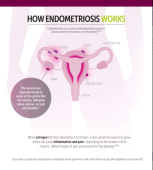
As we get older, we’ve come to realize that so many of our friends, our peers are suffering with pain. Oftentimes, they are suffering silently. Their symptoms are misunderstood by their friends, family and, in many instances, their doctors. Not feeling well is frustrating, and even more frustrating is not being able to pinpoint why you don’t feel well.
So, while uncharacteristic, this month we wanted to offer some insight and education on a commonly misunderstood disease — endometriosis. It happens to be perfect timing as March is Endometriosis Awareness Month.
Endometriosis affects approximately one in ten women in the United States. Yet, according to a recent survey conducted by HealthyWomen – the nation’s leading independent health source for women, less than a third of women correctly recognize all the painful symptoms of endometriosis, including: painful urination, painful bowel movements, and pain during sex. In addition to the general lack of awareness around symptoms, there’s a lack of conversation among those impacted by the disease and clear miscommunication around the illness amongst the medical community.
The survey shows that two-thirds of women respondents know someone who has endometriosis, but the majority say they rarely speak to friends or family about pelvic pain. However, the most disturbing finding was the general dismissiveness of the healthcare community as nearly half of women respondents who identified themselves as diagnosed with endometriosis were told by healthcare professionals that their pain was simply “part of being a woman,” or had their symptoms described as “normal.”
So, today we want to start a conversation about endometriosis and raise awareness of the disease to arm you with the information you need to determine if you may be suffering from this illness.
What is Endometriosis?
Endometriosis occurs when tissue similar to that normally found in the uterus begins to grow outside of the uterus, leading to long-term pelvic pain (during or between periods), pain with intercourse and other painful symptoms. These growths are called lesions and can develop on the ovaries, the fallopian tubes or other areas near the uterus, such as the bowel or bladder.
What are the symptoms?
Here are some of the leading symptoms:
- Painful menstrual cramps, which may get worse over time
- Pain during or after sex
- Painful bowel movements or painful urination during menstrual periods
- Pain in the intestine or lower abdomen
- Heavy menstrual periods
- Premenstrual spotting or bleeding between periods
For a more complete list of symptoms visit: MEinEndo.com
Is there a cure?
There is no cure for endometriosis and the associated pain is currently managed with oral contraceptives, progestins, danazol, nonsteroidal anti-inflammatory drugs, opioids and GnRH agonists. In more extensive cases surgical treatments, like laparotomy or laparoscopy, are often pursued but may be not curative for all individuals
I think I have Endometriosis, what do I do now?
We are not doctors, so we can only recommend that you consult your OBGYN.
However, before your visit make sure to do your homework. Rely on trusted resources like MEinEndo.com and endometriosis.org.
Conducting your own thorough research and arming yourself with questions is the first step towards diagnosis.
And, don’t forget, you are your own best advocate when it comes to maintaining your health and wellness, so make sure your voice is heard.










